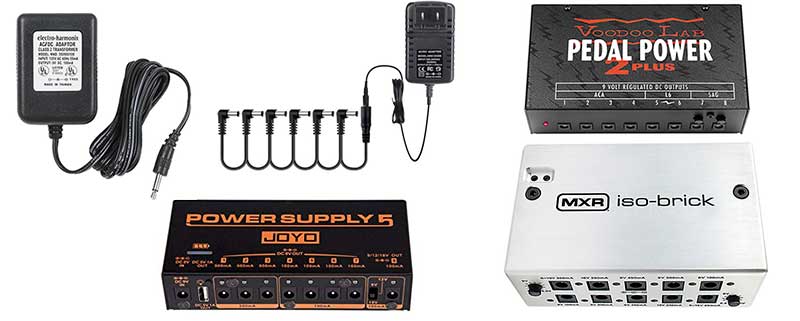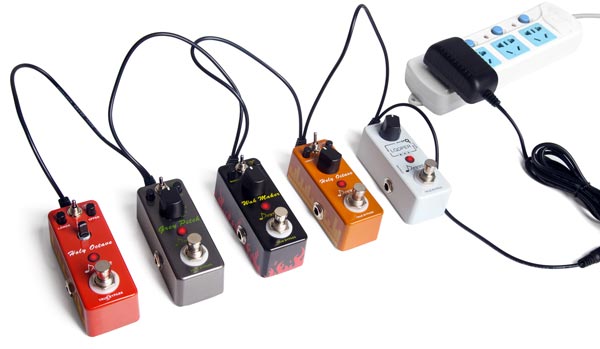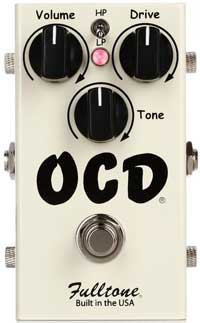Most guitar pedals require 9V either from a battery or external power supply. If you have a 12V adapter, you might wonder whether you can use it to power your 9V guitar pedals.
In most cases, you cannot use a 12V adapter to power a 9V guitar pedal. Using a 12V adapter on a pedal designed to only handle 9V can completely destroy it. There are some guitar pedals built to handle voltages higher than 9V. Those pedals will work perfectly fine with a 12V adapter. Check the pedal’s manual before you try plugging a 12V adapter into any pedal.
Before you plug any adapter into a guitar pedal, it’s important you understand the power requirements of the pedal. Voltage is only one part of the picture and even if you get the voltage right, it’s possible for a power supply to ruin your pedal. Find out everything you would want to know about powering your guitar pedals in this guide.
Running A 12V Adapter On 9V Guitar Pedals
Running a guitar pedal designed to only handle 9V with a 12V adapter can potentially ruin your pedal. If the capacitors inside the pedal aren’t designed to handle 12V and you plug a 12V adapter in, they’ll burn out.
Some guitar pedals do have overvoltage protection, but that doesn’t mean the pedal will work above the maximum voltage. If you plug a 12V adapter into a pedal with overvoltage protection, your pedal might survive, but the overvoltage protection will probably burn out. It may burn out immediately, or it may take some time before it fails.
Before you even consider plugging a 12V adapter into your pedal, find out for sure whether the pedal is designed to handle more than 9V. Most pedals aren’t. Read through the pedal’s manual and if it only says 9V, do not plug a 12V adapter into the pedal.
There are plenty of forum posts out there of guitarists saying they plugged a 12V or 18V power supply into their pedal and while it worked or a day or two, it eventually burned out. So even if you plug it in and it works fine, your pedal may burn out.
Think of voltage as the amount of water you’re trying to push through a garden hose. If you connect a garden hose to your home’s water outlet, the hose will be able to easily handle the pressure of the water. But imagine connecting a garden hose to a fire hydrant. The amount of pressure would instantly burst the ends off of the hose or split the side. A garden hose (9V pedal) is not designed to handle pressure from a fire hydrant (12V adapter).
It’s the same with voltage and your guitar pedals. Trying to connect a 12V or 18V power supply to a 9V guitar pedal is asking for serious trouble.
If the pedal is only designed to handle 9V, buy a 9V power supply (link to Amazon for a range of different 9V adapters and dedicated power supplies). They’re cheap and will last a very long time.
The below photo shows the different types of power supplies you can use on guitar pedals:

In this guide, I explain how to decide which type of power supply may suit your needs. If you’re trying to use a 12V adapter because you don’t have a 9V adapter, read through the guide to find out what type of power supply you should get.
Running Multiple Pedals From One 9V Adapter
If you already have a 9V adapter and buy another pedal, the good news is that you don’t need to buy another 9V adapter. It’s possible to use the same adapter to power both pedals.
You can power multiple guitar pedals from one adapter using a method called Daisy Chaining:

Daisy chaining is as simple as buying a connector lead that allows you to plug multiple guitar pedals into your 9V power supply.
To learn how to properly daisy chain your pedals, read through this comprehensive guide.
Guitar Pedals That Can Accept More than 9V
While most guitar pedals only run on 9V, some pedals are designed to accept higher voltages. The pedal will either label what voltage range it can handle on the pedal, or you might need to check out the manual.
The below photo shows what to look for on your pedal before you plug a 12V or 18V power supply into your pedal:

When a pedal says “9 – 18V”, it means it can accept voltages anywhere within that range. That means you can use a 9V power supply, a 12V supply, or an 18V supply without any problems.
A common example of a guitar pedal that accepts 9 – 18V is the Fulltone OCD.

Overdrive pedals like the OCD often allow higher voltages because a higher voltage can increase headroom. This means you’re able to get higher volumes out of a pedal before it starts to break up.
Higher headroom is great for guitarists who like very transparent overdrive pedals. A higher voltage (if your pedal is designed to handle it) can give you more room to boost your signal without breaking the tone up.
The Fulltone OCD is popular partly because it does sound a lot better at higher voltages. Many guitarists run their OCDs at 18V to give it the highest headroom possible.
Another common type of pedal that may benefit from higher voltages is fuzz pedals. Many fuzz pedals will sound different when you run a higher voltage through them.
On the front of the Wampler Fuzztration (find out more about the Fuzztration and other fuzz pedals here), you can see it accepts anything from 9V to 18V:

Some guitarists prefer the sound of a fuzz pedal with a higher voltage, while others prefer to stick to 9V. If your fuzz pedal is known to handle higher voltages and you have a 12V adapter, you can plug it in and get an idea whether you prefer the sound or not.
Try to switch between a 9V power supply and a 12V adapter and listen for any differences in tone and headroom. Higher voltage doesn’t always mean better tone, so run a test to find out what you prefer before you decide on a voltage for your pedal.
Here are some examples of guitar pedals known to handle higher voltages:
- Fulltone OCD (9 – 18V)
- Wampler Fuzztration (9 – 18V)
- Most MI Audio Pedals (9 – 24V)
- MXR Flanger (18V)
- MXR Stereo Chorus (18V)
- Pigtronix Envelope Phaser (18V)
- EarthQuakerDevices The Depths (9-18V)
There are far more guitar pedals than what I’ve listed above, so before you try plugging a 12V or 18V adapter into your pedal, check the pedal’s website and read the manual. Don’t ruin your pedal by overpowering it with voltage it wasn’t designed to handle.
As you can see from the above list, some pedals allow you to connect different voltages to the pedal (eg: Fulltone OCD), while others require a specific voltage (eg: MXR Flanger requires 18V only).
The main point to remember here is to only plug a 12V or 18V adapter into your pedal if you’re 100% sure it is designed to handle it. Electricity is not something to play around with. Do research on your pedal or buy a 9V adapter to play it safe.
